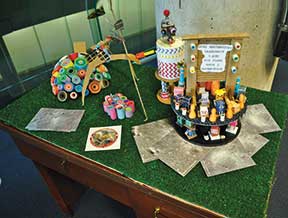Vidushi Chaudhry
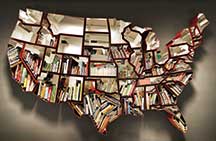 If you have been to a library in India, it is one of three kinds – the large university library, filled with musty old books that wear an air of neglected despair as they are only frequented at exam time; the school library manned by an overzealous librarian, typically someone who shushes and shoos, allowing you to take only a trickle of books home, no matter if you are a voracious or gluttonous reader; the small neighbourhood library, sometimes in a little corner of the market, often on a plastic sheet on the side of a road strewn with popular fiction/pirated DVDs and material you wouldn’t want to view with your parents. If you are like most families, you haven’t been to a library together or thought there was a need to.
If you have been to a library in India, it is one of three kinds – the large university library, filled with musty old books that wear an air of neglected despair as they are only frequented at exam time; the school library manned by an overzealous librarian, typically someone who shushes and shoos, allowing you to take only a trickle of books home, no matter if you are a voracious or gluttonous reader; the small neighbourhood library, sometimes in a little corner of the market, often on a plastic sheet on the side of a road strewn with popular fiction/pirated DVDs and material you wouldn’t want to view with your parents. If you are like most families, you haven’t been to a library together or thought there was a need to.
Six months ago, when I made the life-altering decision to move to the US, I decided to explore it through visiting its libraries. As an educator, a book lover, and a borderline nerd, I marvel at what the library system has accomplished here and think developing nations like India would benefit from the best practices used here.
This article is the first part of a two part series where I attempt to crystallize my own understanding of the library system in the US and implement learning in the Indian context.
I write this from the Phoenix Public library where a business seminar is running for newbie entrepreneurs at the HIVE; the College Depot librarian is helping students figure out how to get financial aid; students work diligently on their computers in the Quiet area; an art exhibit invites you to stop and engage; and books, movies and magazines welcome you for a browse.
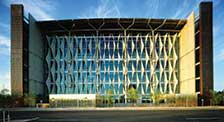
The Burton Barr library’s unusual design makes it a Phoenix Point of Pride
The US library originated with the idea of giving equal access to education and learning, irrespective of financial ability. The lofty aim defines much of what I have experienced so far, and increasingly, the library has redefined its purpose from being a place where people could check out books to a place of intellectual, social, economic, and community stimulation.
To me, it has evolved as a means of governance to serve its people. So the city of Scottsdale offers support to budding businesses, recreational activities to seniors, vibrant storytelling to its little ones and a culture pass to those without means, so that they can experience Arizona’s lovely museums for free.
The reading castle houses books for kids & invites them to climb into the towers and curl up with one!

Many libraries give free access to computers, wi-fi, e books, online classes and audio-video resources
So why am I so impressed?
1. The efficiency of services
This is a far cry from the bureaucratic public institutions I was expecting and while there is certainly a slower speed than a private organization, things move smoothly and quickly here. You can obtain a library card in five minutes with minimal paperwork; order materials from another library; check out up to 30 items with a speedy self-check system; and remain apprised of all programs through meetups, mailers, and newsletters. As a volunteer who has seen the ruthless operational excellence at the backend, I think it runs very much as a corporation would. Customer care is important and I have not met a librarian yet who didn’t try to answer my questions or connect me to resources that could answer them.
2. Excellent use of valuable real estate
Every city uses the library’s vast space to serve people through many community outreach programs. In addition to these, each library offers free co-working and meeting spaces, age-specific areas for children and teens; purpose-centric areas like business spaces and college prep; and an array of digital services like computers or even media centres. Community support groups like suicide prevention or addiction help groups are also available at some libraries.
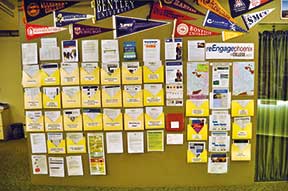
Test prep, application help and counselling are available at College Depot!
Libraries inadvertently serve as a safe haven for the homeless and many like me use it as an office space which is preferable to the lonelier home office.
3. Taking partial responsibility for economic development
Many libraries responded to the economic downturn by creating a job help specialist in each library with the aim of helping library customers find work.
I have worked with a resume writer, attended workshops on optimizing job search, connected with local job help groups, been mentored by a local business leader, joined a networking group, improved my Linkedin profile, all for free here. Similarly, each city offers many resources to entrepreneurs and small businesses to drive economic growth.
4. The effort to make it an inviting space
The teenagers section has cubicles in bright colours and there’s even a video game console in one library. Teenagers congregate in small noisy groups everywhere. Some unplug from the frenzy and listen to headphone music and others find cosy corners to snuggle with a book.

Construction from the Makers, Artists, Crafters and Hackers space
5. The organization of digital content- access to an array of materials
Knowledge and access has become more democratic with the Internet becoming a bedrock of learning. The library, thus, provides paper books, e-books, an array of digital resources like Cds, DVDs, online streaming of classes, and online magazines that you can access from the comfort of your home.
In the quest to remain relevant in a digital world, technology has been embraced willingly and there are frequent free training sessions on everything from Pinterest and Twitter to effective parenting.
The check-in and check-out systems use barcoding technology, and automated reminders alert you as the return date draws near.
Operational efficiency is the byword here.
6. How art and culture are integrated and made accessible to all through the library
Every educator knows that the visuals in a classroom environment lead to passive learning. Towards this end, the library houses art collections, workshops about culture, religion, art, music, and dance.
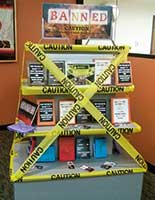
Books that are forbidden act as a siren song for teen readers!
When I think of the incredible Indian art forms and products available, I think it would be easy to integrate these into learning environments like schools and libraries.
7. Volunteers are seamlessly integrated into the organizational machinery
As anyone who has ever employed a volunteer will know the idea of having a volunteer is often more attractive than the actual experience of having one. A lot of energy and time is spent before volunteers can become contributors. The library system manages a large roster of diverse volunteers successfully. While traditional jobs like stacking book carts exist and are manned, skilled volunteering is also done to create a match between volunteer strengths and library needs. For example, as a special educator, I am now volunteering for the ‘Read to Succeed’ program for at-risk first graders where my skills are utilized effectively.
Seniors or retired professionals looking to meaningfully engage and share their expertise, form a large part of the volunteer workforce. They are given a schedule, a job description and a community to engage in. Those who are transitioning careers are also found in the library system.
8. Day home for the disenfranchised
In my eyes, the library is an oasis for those in the community who are struggling to find their place. Safety and shelter is offered within its confines during the daytime hours and I have often seen people carrying their belongings in plastic bags, waiting for the doors to unlock. For a few hours, the homeless are off the streets.
Similarly, I have observed the lonely engage in conversations, those without employment seek counsel, and those without resources use it as an office. For people who have moved away from their roots, like me, there is a comfort in being here, surrounded by this wealth of the world’s wisdom.
I have always enjoyed Hugo’s quote,” He who opens a school door, closes a prison.” I wonder if there are any statistics available about how many of the at-risk have had their lives or livelihoods saved by the library system.
9. Grants, private funds make much of this possible
Libraries need government sanctioned funding which comes from state, local, and municipal reserves, as well as donations. A quick google search lists dozens of grants available for libraries, librarians, and targeted programs. Philanthropists, foundations, and everyday citizens are encouraged to contribute time, money, and in kind.

The traditional image of a library – grand, intimidating & full of old world charm
10. It’s free
Libraries, like roads, hospitals, schools, and transport systems are slotted under developmental services. This means all this wealth of information, ideas, art, culture, and programs are given to the public free of charge.
To the Western mind this may not appear to be a particularly extraordinary thought, but to my Indian friends, the concept of having free public access spaces like this would be amazing.
Allocating tax dollars and large chunks of prime real estate to make learning accessible to one and all, regardless of their background, language or financial ability, is an excellent investment of time and energy. This is a truly evolved way of thinking and one that differentiates a developed nation from a developing one.
The author is an educator and partner at the Mindsprings Enrichment Centre. She blogs at vidushichaudhryspeaks@wordpress.org.

